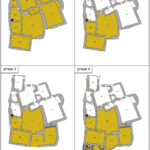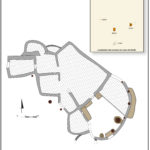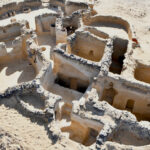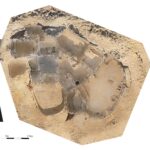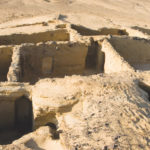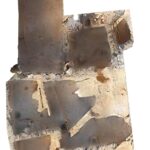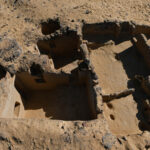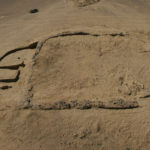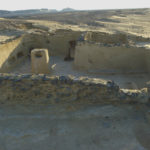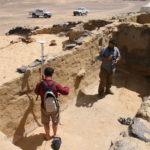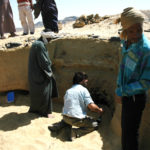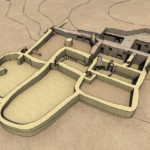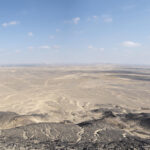TALL ǦANŪB QAṢR AL-ʿAǦŪZ
| Arabic | تل جنوب قصر العجوز |
| French | Tell Ganoub Qasr el-Agouz |
| DEChriM ID | 14 |
| Trismegistos GeoID | 61697 |
| Pleiades ID | - | PAThs ID | 428 |
| Ancient name | - |
| Modern name | Tall Ǧanūb Qaṣr al-ʿAǧūz |
| Latitude | 28.328981 |
| Longitude | 28.916283 |
| Date from | 330 |
| Date to | 750 |
| Typology | Monastic settlement |
| Dating criteria | Radiocarbon dating of organic material found in occupation layers; ceramic; coinage; ostraca. |
| Description | Tall Ǧanūb Qaṣr al-ʿAǧūz is located 2.4km south of the Roman village of Qaṣr al-ʿAǧūz and 3.8km N-W of the Roman farms of ʿAyn Qaffara. The site is situated on the Darb al-Bahnasāwī, the ancient track leading to the Nile Valley, and consists of six 'sectors' comrpising individual structures constructed essentially of basalt blocks and mud, but also of mud bricks, or dug partially or completely in the geological substratum (Ghica 2009: 604). These structures are the remains of a unique monastic community, occupied from the fourth to the end of the sixth centuries. Most of the ceramic dates from the fifth and early sixth, indicating that this was likely the peak of activity, at least in the sectors GQA1, 2, 3 and 6 (Ghica 2019b: 239). Traces of later occupation, dating from the seventh to eighth centuries, have also been identified in GQA1, 2 and 6, probably correlating with the pastoralist re-occupation of the site (Ghica 2019b: 239). The geographic isolation, as well as the organisation of internal space and graffiti indicate the semi-anchoritic nature of the establishment. GQA1 The planimetry of the buildings as well as the techniques make this an atypical laura, with the only parallel found in the earliest structures of Kellia (Ghica 2019a: 126; Ghica 2019b: 240). A general chronology of phasing is as follows: P1a, b and c comprise a single, homogenous unit and belong to the first phase of construction, which was arguably intended for a single occupant (Ghica 2013: 145). P2, 4, 5 and 6 belong to the second phase, while P7 belongs to the third phase, and P3 belongs to the fourth. P8 and P9 belong to the fifth and final phase of construction at this sector (Ghica 2013: 146). Based on stratigraphy, radiocarbon analysis, ceramic assemblages and two coins, the terminus post quem for phase three has been dated to the second half of the sixth century, enabling the foundation date (the first construction phase) to be pushed back to the first half of the fourth century, making it the oldest preserved Christian monastic site that has been dated with certainty (Ghica 2019b: 240). GQA2 GQA3 GQA4 GQA5 GQA6 |
| Archaeological research | The first work conducted on the site was carried out by the Supreme Council of Antiquities, during the 1990s. During this campaign, two rooms of GQA1 were cleared, however no documentation is available. This was then followed by two seasons of excavation conducted by the Institut français d’archéologie orientale (IFAO) led by Victor Ghica, first in 2009, then in 2013 and 2020. |
• Ghica, Victor. 2009. “Bahariya / Ganub Qasr al-‘Aguz.” Bulletin de l’Institut français d’archéologie orientale 109: 604-606.
• Ghica, Victor. 2012. “Pour une histoire du christianisme dans le désert Occidental d’Égypte.” Journal des savants 2: 251-253 and fig. 18.
• Ghica, Victor. 2013a. “Tell Ganub Qasr al-‘Aguz.” Supplément au Bulletin de l’Institut français d’archéologie orientale 113: 145-154.
• Ghica, Victor. 2013b. “Le christianisme des déserts.” Supplément au Bulletin de l’Institut français d’archéologie orientale 113: 143-145.
• Ghica, Victor. 2014. “Le christianisme des déserts.” Supplément au Bulletin de l’Institut français d’archéologie orientale 114: 108-112.
• Ghica, Victor. 2016. “Vecteurs de la christianisation de l’Égypte au IVe siècle à la lumière de l’archéologie.” In Acta XVI congressus internationalis archaeologiae christianae Romae (22-28.9.2013). Costantino e i Costantinidi: l’innovazione costantiniana, le sue radici e i suoi sviluppi, edited by Olof Brandt, Gabriele Castiglia and Vincenzo Fiocchi Nicolai, pars I, 239, 249 and fig. 9, 10, Città del Vaticano: Pontificio Istituto di Archeologia Cristiana.
• Ghica, Victor. 2019. “L’archéologie du monachisme égyptien au IVe siècle: état de la question.” In Nag Hammadi à 70 ans. Qu’avons nous appris ? Nag Hammadi at 70: What Have We Learned? (Colloque international, Québec, Université Laval, 29-31 mai 2015), edited by Eric Crégheur, Louis Painchaud, Tuomas Rasimus, 126-127 and fig. 1, 2, 3, Leuven–Paris–Bristol: Peeters.
• Ghica, Victor. 2019. “Ganoub Qasr el-Agouz (oasis de Bahariya).” In Archéologie française en Égypte. Recherche, coopération, innovation, edited by Laurent Coulon and Mélanie Cressent, 236-241, Cairo: Institut français d’archéologie orientale.
• Ghica, Victor, Rhiannon Williams, Zulema Barahona Mendieta and Valérie Schram. 2021. “Culture matérielle du christianisme égyptien : les déserts Occidental et Oriental,” Bulletin archéologique des Écoles françaises à l’étranger [En ligne], Égypte, mis en ligne le 30 mai 2021, consulté le 22 juin 2021. URL : http://journals.openedition.org/baefe/2849


 Json data
Json data

